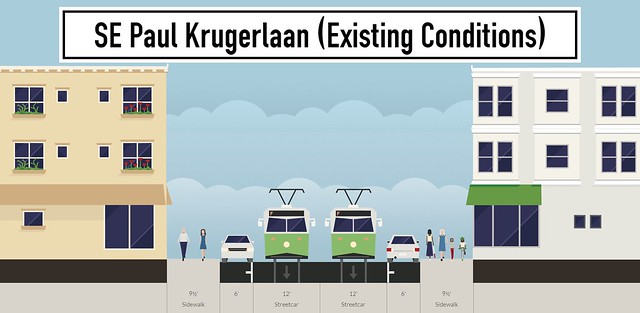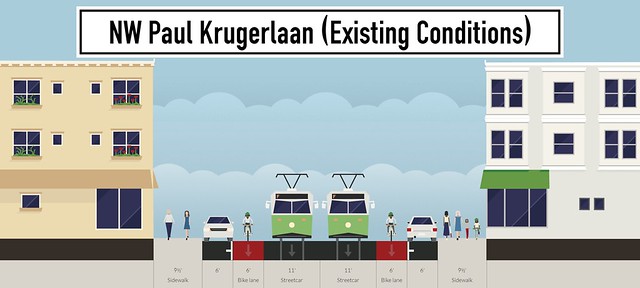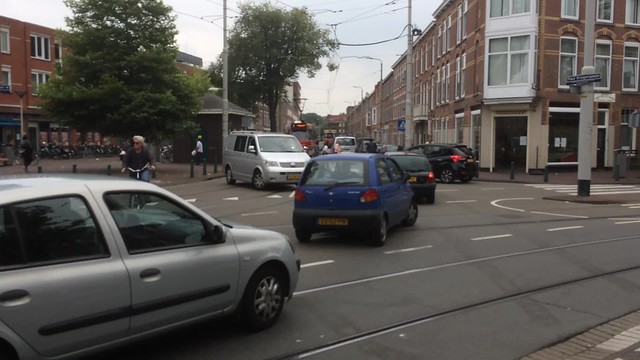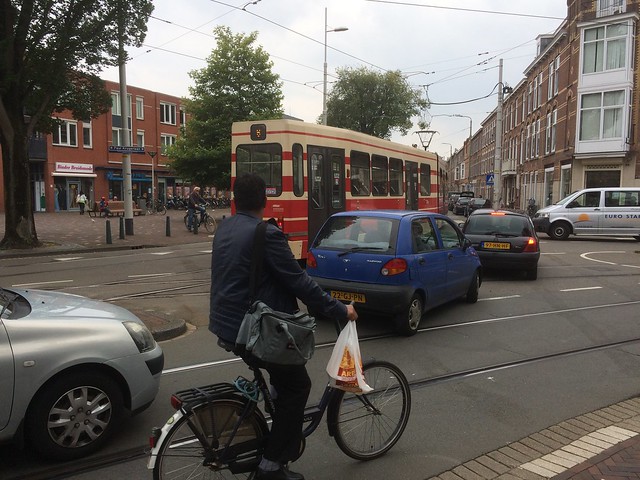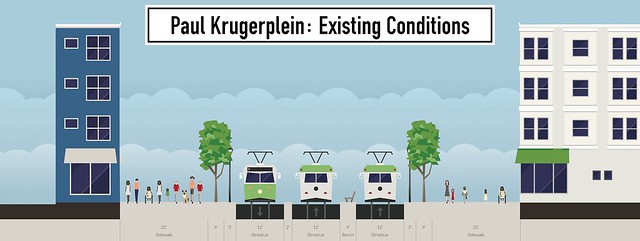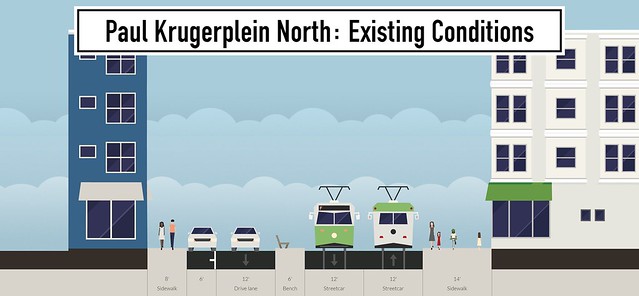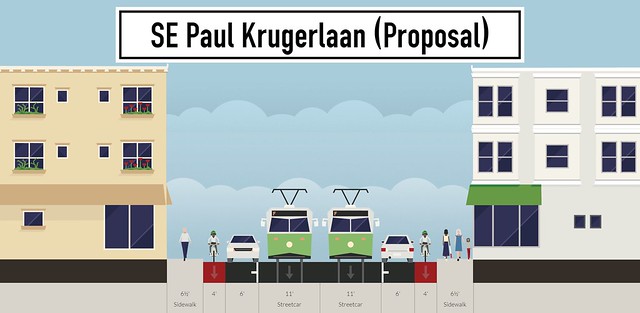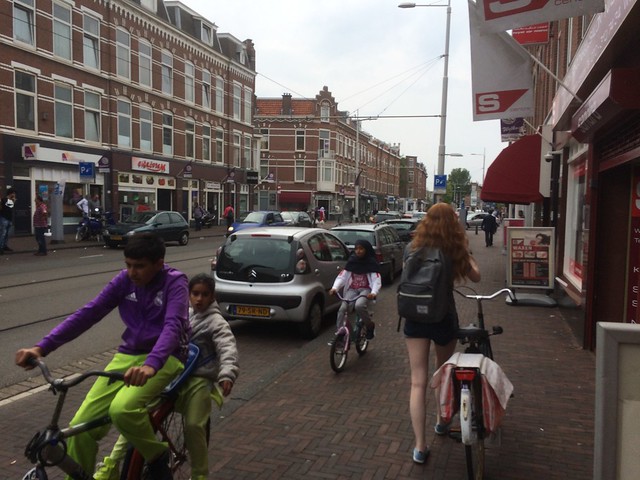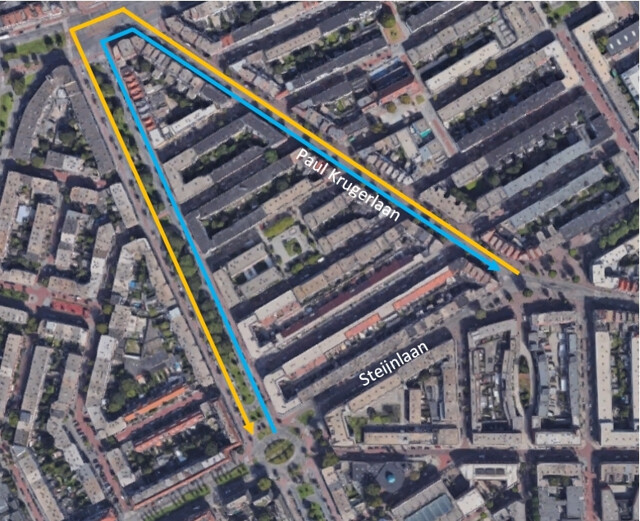Paul Krugerlaan/Paul Krugerplein
Alison Lunny and Ramzi Talhouk
Background
Paul Krugerlaan and Paul Krugerplein are located in the Centrum district of the Hague. This district is the oldest in the Hague and the second-most populous, with about 99,300 inhabitants as of 2013. Within the district are nine neighborhoods. Paul Krugerplein is located within the Transvaal neighborhood. Transvaal is an area heavily populated by immigrants. In fact, over 90% of its 15,500 inhabitants are immigrants of primarily Moroccan, Turkish, and Surinamese origin. These 15,500 people make up one of the most densely populated neighborhoods in the Hague. Paul Krugerlaan is one of the main collector/distributor in this densely-populated neighborhoods, making it quite populated with cars around rush hour. In addition, the street is part of the routes of two different HTM tram lines.
Existing Conditions
Southeast Portion of Paul Krugerlaan

https://goo.gl/maps/sprahRb4w9J2
In this section of the city, city planners have to have enough space for the 6 and 12 trams along with stops for each, medium car traffic for most of the late afternoon to evening, pedestrians, and bikers coming from and going to a two way cycle track (this cycle track is perpendicular to Paul Krugerlaan at Paul Krugerplein). Right now, the intersection is extremely busy and the lack of traffic signals means that as a biker, you have to yield to at most seven other road users to cross the intersection. We experienced that this was stressful, and that in order to actually cross, you have to just bike out into the intersection and hope oncoming traffic stops because it is such a busy road.
The current design on the southeast section Paul Krugerlaan is shared traffic with trams, cars, and bikes and parked cars on both sides of the road (see picture below). As one can see, the road itself is only 55 feet, so this road needs to serve a lot of functions with a limited amount of space.
One can hardly imagine biking and having a streetcar following you. This is extremely unsafe, and despite the danger of biking down this street, when we visited the area, we still saw bikers (about two bikes to every five cars) riding down the street. Even though this is a car-focused road, since bikes still ride on it, city planners have to plan for the safety of the bikers.
Northwest Portion of Paul Krugerlaan
https://goo.gl/maps/94vF8SsvpHG2
The northwest section of Paul Krugerlaan is ten feet wider than the southeast section (65’). Because of this extra space, bike lanes are already in the design. Because there is space for everyone on this section of the road, we decided not to change this section of the road in our proposed design.
Paul Krugerplein
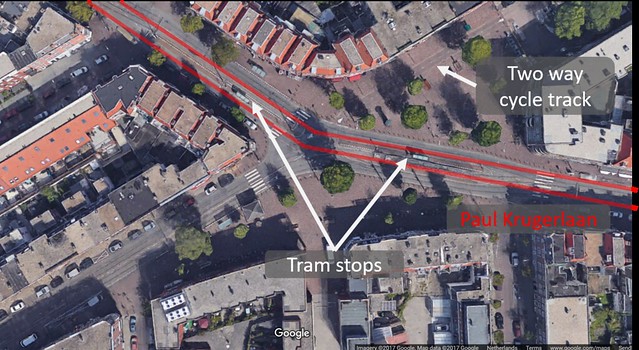
https://goo.gl/maps/ajjN3TrUph52
Paul Krugerplein is a busy, unsignalized intersection between the southeast and northwest portions of Paul Krugerlaan (two way car, tram, and bike traffic). At Paul Krugerplein, Paul Krugerlaan intersects with Steijnlaan in the southwest and a two-way cycle track in the northeast. This intersection is one of the more hectic and poorly designed that can be seen in the Netherlands. Included below is a video of a few seconds of this intersection at rush hour. The video exposes many different inefficiencies of the intersection.
Paul Krugerlaan assumes priority at the intersection, however, there are trams that come from Steijnlaan and are therefore forced to wait in a line of cars that want to turn onto Paul Krugerlaan. From the start of the video, there is already a tram stopped at the intersection, where it must wait for an additional thirty seconds. These trams are operated by HTM, a company that believes waiting any longer than ten seconds at an intersection is a long time.
Another glaring fault of the intersection is the lack of bicycle facilities. There is absolutely no consideration for bikes in the intersection whatsoever, forcing them to adopt vehicular cycling as they go through the intersection, something that is dangerous given the volume of cars and trams that pass through the intersection (see photo below). Furthermore, the two-way cycle track that approaches the intersection from the northwest comes to an abrupt end at the intersection, leaving bicycles to yield to two directions of car, bike, and tram traffic, and traffic turning onto Paul Krugerlaan. At 40 seconds of the video, a cyclist can be seen dangerously crossing the intersection from the cycle track.
Below is a street mix of the southwest entrance to Paul Krugerplein on Paul Krugerlaan. As you can see, there is a tram stop in the middle (streetcar only) lane and there are two travel lanes with autocar and streetcar mixed. There are really wide pedestrian areas on either side of the intersection so there is a lot of pedestrian crossings. This can be problematic especially when there are cars making lefts because pedestrians have to look at multiple angles when crossing the street.
In the northwest entrance to Paul Krugerplein from Paul Krugerlaan, there is one autocar only lane, one streetcar only lane, and one mixed lane. While the pedestrian areas are not as large, there is still a lot of foot traffic and lots of pedestrians crossing the street, with the same problems as mentioned above.
Design Proposal
Southeast Portion of Paul Krugerlaan
We will redesign the Southeast portion of Paul Krugerlaan to have bike lanes protected by parked cars. We chose to do this because we saw that while having streetcar and autocar traffic combines is not optimal, it is relatively safe because the streetcars can easily see autocars. However, the idea of having bikers with or even next to streetcars worried us because bikers are shorter than autocars, they are more easily hurt, and streetcars take longer amounts of time to stop than autocars. We also acknowledge that the sidewalks will be shortened by five feet on each side, and we justify this because even now a lot of bikers bike on the sidewalk to avoid the daunting street (see picture below). We also found it unavoidable, given the limited amount of space, to not have a dooring risk. But there is a lesser dooring risk when the bikers are on the right side of the parked car (the passenger side), and if a biker was to get doored, they would fall into the sidewalk instead of a busy road.
We decided to keep parking on both sides of the road, but every third parking spot we will put in an area for bike parking. This will get rid of a lot of bikes being parked in the sidewalk, clearing up some space for pedestrians, and we think that the parked car volume can handle it because when we visited the site at rush hour, not every spot was filled, as shown in the picture below.
We also put in two one way cycle tracks instead of a single two-way track. We did this because there are shops and residences on both sides of the street, and if one side were to not have bike facilities, it is very hard to cross the road to get to the potential two-way track.
Northwest Portion of Paul Krugerlaan
As mentioned in the existing conditions, due to the time constraints of this project,we decided to keep the Northwest portion of Paul Krugerlaan as is and because every road user has their own space.
Paul Krugerplein
Because the intersection at Paul Krugerplein is such an unusual shape, and because there are so many tram tracks and stops, it would be very difficult to effectively and cheaply redesign the entire intersection. Therefore, we decided to just eliminate all left hand turns in the intersection. This will free up an area in the middle of Paul Krugerplein which we would pave with either stamped asphalt or brick. This brick median serves as a visual reminder to driver that the area cannot be crossed, thus enforcing the no left turn rule. This is also an area where crossing bikes can wait in between crossing lanes. Before, bikes had to yield to at most seven other intersection users, and now they only have to yield to at most two at a time. Eliminating the left turns also reduces stop time the 12 tram (the tram coming from the northwest section of Paul Krugerlaan to the southmost track on the southwest portion of Paul Krugerlaan) because it no longer has to wait for cars to finish turning, it just goes through the intersection and then merges into traffic.
Eliminating left turns in Paul Krugerplein will not significantly inconvenience drivers navigating the area. The two left turns possible are from Paul Krugerlaan northbound to Steijnlaan westbound, and from Steijnlaan eastbound to Paul Krugerlaan northbound. Both routes have reasonable alternatives. Drivers looking to access the northern half of Paul Krugerlaan from the west may follow the blue line on the figure below. This line follows De la Ruyweg straight to a right turn onto Paul Krugerlaan. Drivers looking to turn westward onto Steijnlaan from Paul Krugerlaan can follow the yellow line and continue on Paul Krugerlaan before turning left onto De la Ruyweg. Also an option for these drivers is Kempstraat, another east-west collector road a few blocks south of Steijnlaan.

